|
Effendi
Askari Officers of the German
East African Schutztruppe and Polizeitruppe
| |
Background of the Effendi
The rank of "Effendi" was unique to the
Schutztruppe and
Polizeitruppe of German East Africa. When the Wissmanntruppe
recruited Sudanese askaris (formerly of Anglo-Egyptian service) for
service in East Africa, it was not only other ranks that were
employed. A number officers were also employed by the
Germans as it was felt that the askaris would be more easily led by
officers familiar with their language and
customs. These officers were known as "Effendi", after the Arabic
title used in their previous employment. Although Effendi is often
used to mean African officers and most Effendi
were African, some of the original Wissmanntruppe Effendi originated from
all around the Ottoman Empire including its Asian and European extents.
At first these officers retained their
ranks from their previous service- lieutenants, second lieutenants, captains (and possibly a
major). In the mid 1890s these ranks were dispensed with to form a
single rank of
Effendi. As relations between the German officers and their askaris
improved, it was felt that the Effendi were no longer needed and
they were gradually being phased out with no new promotions
from askari NCO ranks given. By 1914 there were only two
Effendi serving in the Schutztruppe of German East Africa. During the First
World War however at least three further askari NCOs were promoted
to the rank of Effendi for exemplary service and leadership.
Uniforms of the Effendi
The Effendi wore the same khaki and white uniforms as
German Schutztruppe Officers and NCOs but without the blue piping. Matching trousers were
sometimes worn loose over their boots without other ranks puttees, in
the style of German officers when not on active service. Headdress for
the Effendi was the same as for askari other ranks, either a red fez or
a khaki tarbush but with a large yellow metal eagle for the Effendi. As
with German officers, Effendi were entitled to carry a sword rather
than the bayonet carried by African other ranks.
Period photographs show that the Effendi
sometimes wore uniforms showing personal irregularities from these
official descriptions. These range from not having a Tarbush eagle at
all or wearing riding boots to still wearing their old Anglo-Egyptian
army dark blue parade tunic in one photograph.
|
|
|
|
|
|
|

Figure 1
Schutztruppe
Effendi
c1892 |
The Illustrations
Figure 1 is based on a photograph
of a Schutztruppe Effendi taken in the early 1890s. As
mentioned above, not all Effendi were African, this particular
Effendi Fahim was of Greek origin. He wears
the same uniform as a German Schutztruppe
Officer of the period (dark
khaki, six brass buttons, four pockets with a brass imperial crown on either end of
the stand and fall collar) but with an askari red fez. He wears two
brass stars on his shoulder straps denoting him as an Oberleutnant. His
medals are those earned in both German and Anglo-Egyptian service
and from left to right are the
German War Service Medal ("Kriegerverdienstmedaille"), the
British Egypt Campaign Medal with two clasps and the Egyptian Khedive’s
Star Medal.
Recommended External Link -
Photos of a Medal Bar at the Gentlemen's Military Interest Club)
Figure 2 is based on a photograph
of a Schutztruppe Effendi taken sometime in the early
20th Century. He wears the German Schutztruppe 1896 khaki tunic,
without blue piping and with plain khaki shoulder straps with three
white metal stars on the shoulder straps. Like the previous figure he
wears the off duty
red fez in place of a tarbush and wears medals both from German
and Anglo-Egyptian service (most likely the
German War Service Medal and the British Egypt Campaign Medal). He carries a sword as befitting his rank,
although it may not have been carried in action. Note that this
Effendi curiously wears a Schutztruppe officers belt buckle with an
other ranks brown leather belt and a strip of the officer's silver,
red and black belt worn to one side of the buckle. He wears brown
leather riding boots. |

Figure 2
Schutztruppe
Effendi
c1905 |
| |
|
|
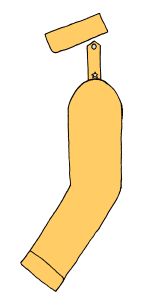 |
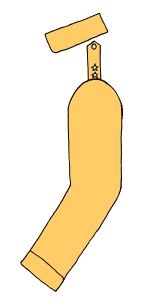 |
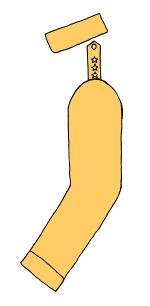 |
Rank Insignia of the Effendi
Rank was displayed in the form of five-pointed, brass (white metal after
1896) stars running up the shoulder strap.
In the early stages of the
formation of the Schutztruppe, when different Effendi ranks existed one
star denoted a lieutenant, two denoted a second lieutenant and three
denoted a captain.
During the 1890's, when these distinctions of rank
were dispensed with, all Effendi were entitled to wear three stars. |
Fig A
Leutnant |
Fig B
Oberleutnant |
Fig C
Hauptmann |
|
|
|
|
Period
Photographs
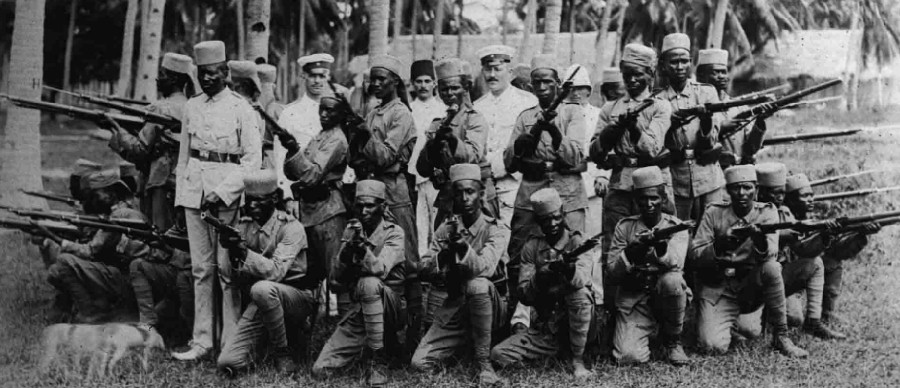
Schutztruppe Feldkompangie in Training c1891-97
This photograph shows Sudanese askaris of the East African Schutztruppe
rehearsing a defensive position as used against local tribesmen. The
askaris wear the kahki uniform with kahki Tarbush without compnay numbers or the
imperial eagle. The two German officers or NCOs wear the white 1891 uniform with
white peaked caps with blue hatbands. A third German can be seen in the right
centre background with a white tropical helmet.
Of particular interest is the Sudanese Effendi in
the left foreground of the photograph wearing the askari Tarbush but
with the German pocketed tunic and trousers worn loose rather than in
dark blue grey puttees like the African other ranks. He appears to be
resting his left hand on a sword, as authorised for the Effendi. Also
note in the centre background another Effendi, in red fez and white
uniform. From his appearance he may be Egyptian.
Photo ©
Frankfurt University Koloniales Bildarchiv
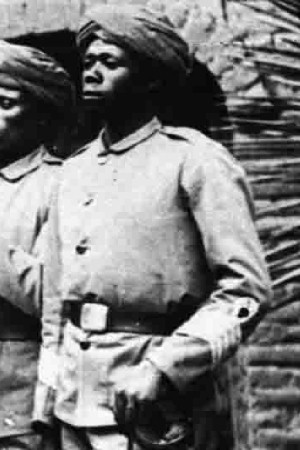 |
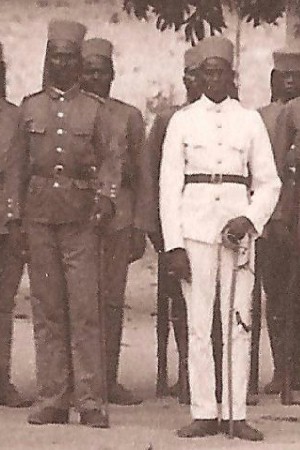 |
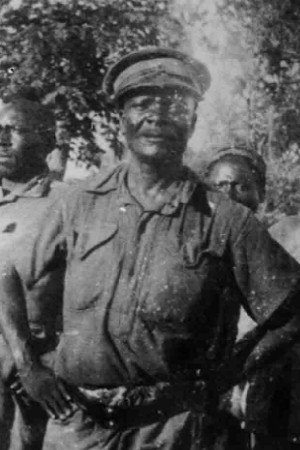 |
|
Sudanese Effendi
Wissmanntruppe,
Cairo, Egypt 1889
This Effendi wears the Sudanese askari khaki tunic and grey turban.
His rank is displayed by the carrying of a sword and in the form of five
pointed lace bars with a loop on his cuffs. This may an old ranking
system dating from his previous service in the Anglo-Egyptian army or it
could be a new temporary insignia issued by the Germans. It is not known
if this system was ever used once the recruited askaris went to East
Africa.
Photo ©
Frankfurt University Koloniales Bildarchiv
|
Two Effendis
Schutztruppe c1891-1897
This photograph shows two Effendis on parade. They both wear variations
on the 1891 Schutztruppe uniform.
The Effendi on the left wears a
khaki uniform similar to that worn by German officers with
Brandenburg cuffs (note the the visible buttons on each cuff) and four pockets. His plain khaki shoulder
straps have a number of stars to denote his exact rank. The
Effendi on the right wears a white uniform similar to that worn by
German officers with and four pockets. The cuffs appear to be plain. His
shoulder straps cannot clearly be seen but may have a number of stars to
denote his exact rank.
They both wear
askari tarbushes
without insignia as do their other ranks. They have trousers
to match their khaki and white uniforms worn loose over short brown
leather ankle boots and carry swords to further denote their
officer status. See more details of this photo
here.
Photo
©
Karsten Herzogenrath |
Effendi Mitambo
11. Feld-Kompagnie, Schutztruppe c1916-18
Like all East African Schutztruppe late in the First World War Effendi Mitambo
has little if anything of his former uniform. Mitambo started the war as
an NCO Sol and was promoted to Effendi during the campaign. The short sleeved shirt
and belt are certainly not Schutztruppe issue, though the trousers may
be. The field cap may be captured British stock to signify his officer
rank in the absence of shoulder straps.
Photo ©
Frankfurt University Koloniales Bildarchiv |
Sources
"Das Deutsche Heer, Friedensuniformen bei
Ausbruch des Weltkrieges " by H. Knötel and P. Pietsch (Diepenbroick-Grüter &
Schulz, Hamburg 1935)
"Askari und Fitafita - Farbiger Söldner in den deutschen Kolonien" by Thomas
Morlang (CH Links)
"German Schutztruppe in East Africa 1889-1911" by Ernst Nigmann translated by
Robert E Dohrenwend (Battery Press)
"The German Colonial Troops 1889-1918" by
Jürgen Kraus and Thomas Müller (Verlag
Militaria)
"Die Deutsche Schutztruppe 1889/1918"
by Werner Haupt (Dörfler Publishing)
"Deutsches Kolonial-Lexikon" by Dr. Heinrich
Schnee (Quelle & Meyer, Leipzig 1920
"Die Kaiserliche Schutz- und Polizeitruppe für Afrika" by Reinhard Schneider (Druffel
& Vorwinkel-Verlag)
Photographs from the
Frankfurt University Colonial Archives and the
Axis History Forum
|
|
Please
contact me here if you have more
information or photos on this topic.
Back to
Main Menu for German Colonial Uniforms
|
|